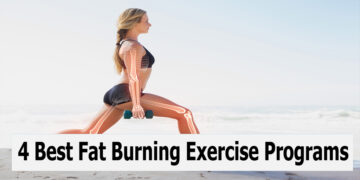Introduction
If you find yourself carrying a little extra “cargo”, you are far from alone. Current statistics report that as many as 40% of Americans are overweight. Fret not, however, the fact that you are reading this article is a clear indication that you have identified an issue.
Unfortunately, taking the first step in resolving the issue can feel overwhelming due to the massive amount of information out there demanding you to do a million different things. Throughout the course of this discussion, we will examine four different training styles that provide a simple and effective means of getting rid of that excess body fat.
Strength Training
For a large number of individuals, strength training is nothing more than a means to build rock-hard muscle. This interpretation is more than enough incentive to become involved in lifting weights for a lot of us. However, if your primary goal is to burn body fat, strength training has still got your back!
Check out this low-impact yoga posing video series from Traverse Bay Farms.
Losing weight almost always comes down to burning more calories than you consume, simple math. While exercise alone certainly assist this process, what about the other 23 hours per day outside of the gym? Interestingly enough, lean muscle tissue has a very high caloric requirement even during periods of inactivity.
Some estimates state than each pound of muscle tissue added to the body burns an extra 50 calories per day. In a nutshell, the more muscle you build, the more calories your body will automatically burn all the time, every day.
High-Intensity Interval Training (HIIT)
High-intensity interval training is basically cardio on steroids. This form of exercise involves the repetition of short, intense bursts of activity followed by brief rest periods. This could look something like sprinting full speed for 10 seconds followed by walking at a slow pace for 20 seconds, repeated 10 times.
HIIT is superior to typical aerobic exercise in several ways. The first and most obvious reason is that working out at a higher intensity requires more calories. The real magic of HIIT actually begins when your workout is over.
If you experience sore muscles or joints after a training session considering adding tart cherry juice to your after workout routine. This ruby red fruit contains natural compounds to help reduce painful inflammation in the body and joints.
This form of exercise induces a profound metabolic effect, increasing a slew of hormones such as adrenaline and testosterone, which promote an increase in the burning of fat. Sometimes referred to as the “after burn”, this effect continues in the body even hours after the workout ends!
Tabata Method
Tabata is similar to HIIT in that it involves high-intensity bursts followed by rest periods. However, there are enough differences to justify a separate explanation. The Tabata training method includes performing the same exercise for 4 minutes. This time is further divided into 20-second intervals of all-out effort, followed by 10 seconds of rest, for a total of 8 cycles. A great example of this would be performing squat jumps as fast and hard as you can for 20 seconds, then resting for 10 seconds.
Tabata not only possesses the ability to accelerate caloric consumption and induce the “after burn” effect described earlier, it also provides a simplistic approach to weight-loss training that can be practiced by even the most inexperienced fitness enthusiast.
Walking (You Read That Right)
Compared to the other fat burning methods described, walking may seem like the odd man out. Think again! Using your two feet to go from point A to point B is the unsung hero of burning calories. Furthermore, walking doesn’t even need to be considered an exercise program. Just do MORE of it.
As you navigate through the day, you will no doubt identify scenarios requiring you to choose between walking and more convenient modes of transportation. Allow yourself the resilience to make the hard choice. Take the stairs, walk to lunch, enjoy a leisurely stroll down the sidewalk in your neighborhood. While walking may not boast the calorie-shredding abilities previously discussed, the extra fuel used quickly begins to add up!




























